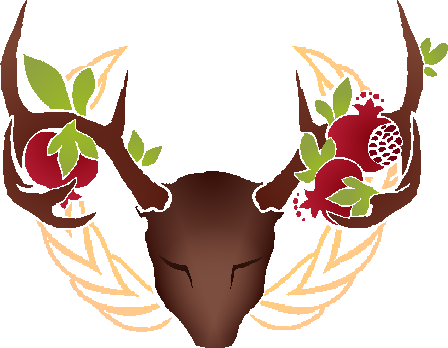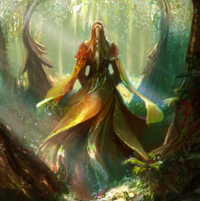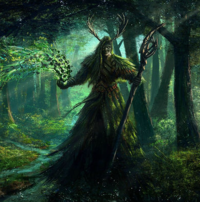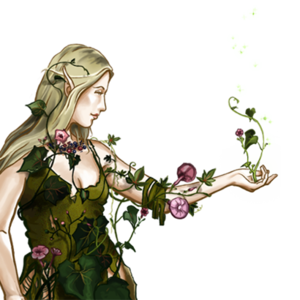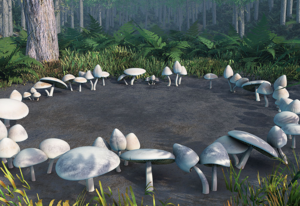Aspectism
Aspectism is the ritual worship of the two gods of the wild, Cernunnos and Cerridwen. It is the main religion of the Dominion of Malin and is the central pillar of culture for Wood Elves, tradition and identity.
| Please note: The following information is IC beliefs held by characters that follow this religion. |
|---|
Contents
Origins
Before the beginning of time and living memory of any mortal being, the world was a barren, inhospitable place. It was in this dawn age that two beings descended down to shape our realm into how we see it today.
The original names of these two gods are lost, remembered only by the wind and the tides. Nevertheless it was they who breathed life onto the rocky wastes. By their guiding hand, the first meadows bloomed into brilliant greens through their gentle kiss, as did the beginnings of mighty forests, vast oceans and shimmering lakes.
The blank canvas that had been the world was now a wondrous landscape. However, the two gods decided they were not finished. The world was unmoving, and needed eyes to savour its beauty, muzzles to enjoy its scents, and ears to hear its earthly songs. And so they began creating the beasts. First the seas were populated with fish, then the skies with the fluttering of songbirds and majesty of hawks. The forest canopies and open meadows were gifted to the wolves, the stags and the wild horses while the earth beneath them was decorated with moles, foxes and mice to burrow away to their heart’s desire.
It was at this point when the world was at its most pure. Everything had a place, a niche, a role to fill. The mortal plane had been shaped perfectly to the vision of the two nameless gods who had worked tirelessly to create paradise.
Then, we arrived.
The beginnings of elf-kind are clouded in mystery. Some say our forefather was manifested alongside his three other brothers by a divine creator. This may have been true, but we were not part of nature’s plan, we did not share the same creator as the trees, the flowers and the beasts that roamed the world we’d been thrown into. Everywhere our first ancestors went, imbalance followed, for we were an extra piece to an already completed puzzle, what we took we did not give back.
Yet instead of scorning us, or obliterating us from their perfect realm, the father and mother of nature took pity upon us. They strove to find us a place in their world. They pondered and pondered, but we were by nature different to anything they had created thus far. So, they gave the elves a gift, as they had done for their own children.
To the birds they gave wings so they might soar through the sky.
To the wolves they gave fangs so they may hunt for their pack.
To the salmon they gave strong fins to push through the upstream tides.
But to us, our ancestors, the two gave something very different. They unlocked our minds.
Where a bear depended on its size to survive, and an elk on its speed, the elves became reliant on their intelligence. With our new divine gift, we spread out through the ancient Aegisian forests and thrived. We developed clothing to keep us warm in the winter and bows to hunt with so we could eat. We had finally found our place in the balance.
The ancient Elves were incredibly grateful to the beings who had given them so much, who had ensured their survival. They devoted themselves to the worship of these beings who they saw as their divine mother and father. In a tongue more ancient than elven, they gave their new deities names to call them by: Cernunnos and Cerridwen. The Aspects of Nature.
Cerridwen, The Mother
Also known as the Green Lady, or Cerridwen- the Mother is the matriarchal side of the balance, depicted as a woman wreathed in leaves and vines, shimmering surreally in many different shapes of nature. Cerridwen is the Aspect of growth, fertility, life and nurturement.
Wood elves believe that all trees, grass and other verdant flora and fauna are born and grow under Cerridwen’s nurturing touch, living until Cernunnos claims them in death.
The green lady is prayed to for good harvest and when growing the massive elderwood trees in which the elves make their homes.
Cernunnos, the Father
Also known as the Horned Man, or Cernunnos- the Father The patriarchal side of the natural balance. He is often depicted as a strongly built man with the horns of a stag and a longbow in hand. Cernunnos is the Aspect of the hunt, of predators, of chaos, and of death.
Wood elves believe that all animals have a deep connection to Cernunnos, and often pray to the horned man for luck when hunting, be it animals or sentient prey.
While Cernunnos depicts death, this is not seen as sinister. For all things must die, and it is simply part of the cycle of nature.
The Balance
The balance is something elves have tried to fully comprehend for millennia, but never have they completely succeeded. However, the simplest way to explain it is to compare it to a scale. The Aspects are weights that keep the scale in balance.
The second way is to simplify the balance into the narrative of opposites. The Mother and Father are each other’s natural counterpart, and thus the two form a perfect whole.
Where the Mother embodies life, the Father is death.
Where the Mother embodies growth, the Father is the hunt.
Where the Mother represents the gentleness of femininity, the Father is the strength and firm hand of men.
The Aspects are called the aspects because they are just that. They embody the aspects of everything. The nature of the world around us, and the nature of our souls. They have grown to know elf-kind very well in the millennia we have spent as their adopted children and servants, as we have gotten to know them. However, we can never truly understand the minds of gods, nor the true complexity of their magnum opus: the balance.
Malin
Malin was the forefather of the elves. The first whom the Aspects spoke to. It was he who was given the gift of intelligence, to which he spread to his children. Malin was a prophet, a speaker of the Aspect’s wisdom. He taught the first elves how to unlock their own minds and discover their sentience as the Aspects had unlocked his. He taught the wisdom of Cernunnos and Cerridwen to all elves, and was the beginning of elven tradition and Aspectism as we know it.
It is said Malin was created alongside three brothers- Horen, Krug and Urguan. Malin’s children were lithe and pointy-eared as he was, they isolated themselves from the descendants of the other brothers and spread out into the deep forests of ancient Aegis.
In the very beginning, Malin did his best to lead his kin, but this was a foreign world that he nor his children were ever meant to inhabit. The Aspects looked upon this lost, alien race with pity, but they could not grant all of them their gift at once. Instead, the two approached the forefather. The first. They saw Malin, and admired his courage and his tireless effort in finding his children a place in this new world, even if they had not the capacity to do so.
It is said that the Aspects descended down upon Malin as he slept on the night of the winter’s solstice. Their fae-like voices stirring him from his slumber. It is said that a single touch of the mother Cerridwen’s index finger to his forehead showed him a world of wisdom he’d never known, showed him how to grow in balance with the Aspect’s own creations. It is said that Cernunnos, the stern father girded Malin with a holy bow- a weapon like none other, so Malin would learn to hunt like the beasts the horned man had manifested into this realm.
Malin was named the Aspect’s new champion, and with their blessing he brought the gift of intelligence upon all his children. By his guidance, the elves learned of the Aspects and learned how to survive in their world.
Malin ruled his people through a thousand years of prosperity until his disappearance. His loss was a huge blow to the elven people, who would be rife with division and infighting ever since.
The Druids
The Aspect’s chief servants, the guardians of nature, and the preservers of culture and tradition. The Druids are almost completely synonymous with the Horned Man and Green Lady. The druids are the priests of the Aspectist faith, maintaining its hold over wood-elven kind both in ancient and modern times.
Druids are individuals who take their devotion to the Aspects and the balance further than anyone else possibly could have. Individuals who put the gods of nature above anything else in their life, without question- over friends, family, wealth and fortune.
In return for their unquestioning obedience and devotion, the Aspects grant druids part of their divine power. The Drui are known to bend the trees and plantlife to their will, and the most ferocious of predators will follow at their heel.
It is said that Malin was the first druid, granted the power to perform miracles within the natural world by the divine two. He was taught the rite of attunement, the ability to spread the Aspect’s gift to his disciples. Through him, druidism spread. The modern druidic order as it is known today was founded by one known as Respiren, but many wood elves believe their origins, and the gift, are far, far older.
In the current day, it is the Naelurir sect of the druids who devote themselves to the education and tradition-conversation of the elven people. The Naelurir are a purely elven druidic circle, with a name meaning ‘ones who teach’ in the ancient tongue. They keep the Aspects teachings strong, and teach their people to know how to live in harmony with the world created by the mother and father, just as Malin did many centuries ago.
Worship
The wood elves of Laurelin have many ways in which they display their love and devotion to the Aspects. Many of these are ancient traditions that go back to the days of Malin himself. Traditions vary greatly from elf to elf, seed to seed, but many transcend these differences.
Petal Lines - Tiva
Flowers are among the most vibrant of the Aspects creations. Their beauty the inspiration of countless poets. As such, several ancient wood elven Seeds took to adorning themselves with the brightest of petals.
Over the centuries, an entire new language developed- the petal line, also known as Tiva. Certain flowers grew to represent certain things- an elf who wore a rose was emphasizing her maiden-hood, one who wore a white lilac was displaying his status as a tree-weaver.
Soon elves would wear entire wreaths of flowers across their hair, their waists and their chest. Anyone fluent in the language of the petals could read the entire life story of an elf by observing the flowers adorned on them.
This tradition is carried on in the current day, though few live who are fluent in Tiva. Any elf who adorns themselves with a petal-line is almost certainly a devout to the Aspects. Tiva is as much a display of an individual’s piety as it is of themselves. To wear the Aspect’s most beauteous creations on your body is to show you live in harmony among their creations, and show your love for their balance.
Offerings
Across wood elven hamlets all over the continent, and especially within the capital of Laurelin, many shrines can be found. These shrines can be simple or ornate, massive tributes to the divine two. Not far from these shrines will be the brazier, the largest and most notable one being within the center of Laurelin itself. Elves devout to the Aspects will regularly pray before these shrines, and throw offerings into the brazier to burn away into the Aspect’s sky.
Making offerings is a an important and symbolic part of the faith’s lifestyle. It is the wood elves main way of showing the Aspects reverence and respect, as well as a good way to call upon their favour. The offerings one makes is reflective of one's values and desires. A hunter will place down a beast's skull at Cernunnos' shrine, while a mother will offer a blooming flower at Cerridwens' feet.
Offerings are usually done to invoke a blessing from the Aspects. The most common of blessings being the good health of a newborn child, luck and strength on a hunt, and so forth. The gifts sacrificed to the Aspects into the roaring brazier are symbolic of these desires. An expecting mother will throw a lilac flower- the Tiva flower of fertility, for a healthy pregnancy. A hunter would throw in the skull of a previous kill to beseech his gods to grant him more in the future.
Pendants
Perhaps the most simple of old Aspectist traditions. It's not uncommon to see a pendant of the Aspects hanging from a wood elf’s neck, or bound to their wrist. It is a basic yet tried and true way of showing one’s constant devotion to the gods of nature who provide so much for them.
The shape and form of the pendant changes on the nature of the worshipper. Those who lean more towards the hunter’s side of the balance will adorn themselves with a broach the shape of stag’s horns in honour of Cernunnos. Those who align themselves more with the mother’s nurturing touch may wear a bronze flower or pomegranate to pay tribute to Cerridwen.
Those who wish to honour both Aspects wear a combination of the two. This combination of the horned man’s stags and green lady’s fruits make the official emblem of the Aspectism religion. (See the first image).
Fae Rings
Fae rings are dangerous to most people. Outwardly seeming like a simple circle of mushrooms, they hold a deadly power to them. Inside, the realms of gods and mortals meet. Any individual who steps inside the fae ring is immediately exposed to voices, thousands and thousands of voices, an alien, and oh so overwhelming song.
In truth, what those who step inside are hearing is the thoughts and voices of all life-forms in the area. It is something druids hear daily, albeit more muted, due to their connection to the Aspects. To the unattuned, a fae ring can be deadly. The voices can overwhelm, and people will soon lose any desire to leave, to the point where they simply wither away and starve within the circle, their minds completely lost to the song.
Many wood elves make pilgrimages to fae rings in the deep forests despite this. Perilous as they are, there is no better way to understand the sheer complexity and beauty of the Aspect’s realm without sitting inside one. The most devout of Aspectist elves will do this at least once in their life-time, almost always with the companionship of a druid to pull them out if they begin to lose their mind.
Those who walk out of a fae ring always come out as changed people. Wisened people.
The Seeds
Seeds are more a secular tradition than a religious one. Nevertheless, their ancient roots and deep connections with Malin and the Aspects make them an integral part to the Aspectist faith. Each Seed has its own unique ilmyumier, the seed tattoo. These range from blood-red inking of stag horns, to ocean blue wave like patterns, to dark green swirls resembling the branches of a mother oak tree. An elf who belongs to a seed is easy to point out due to their painted nature.
In ancient times, ‘Seeds’ were tight knit bands of Wood Elves who roamed the ancient forests of Malinor. There were dozens of Seeds, each capable of living in harmony with nature in ways that could hardly be comprehended in modern times.Being part of a seed has become synonymous with being Aspectist. In a world where many elves have strayed from the Aspects path, to take up the Seed lifestyle and ink your skin to show you belong to one is essentially embracing the ancient way- the Aspect’s way.
In the present-day Wood Elven State, Seeds are an echo of the past. Instead of being large, nomadic tribes, the Seeds of today are associated with the nation’s prominent families, bound by blood or adoption. Seeds are usually formed of a blood-related core surrounded by a periphery of adopted individuals or families. In addition, some seeds focus on a specific calling, such as warfare or administration.
Links
|
|||||||||||||
